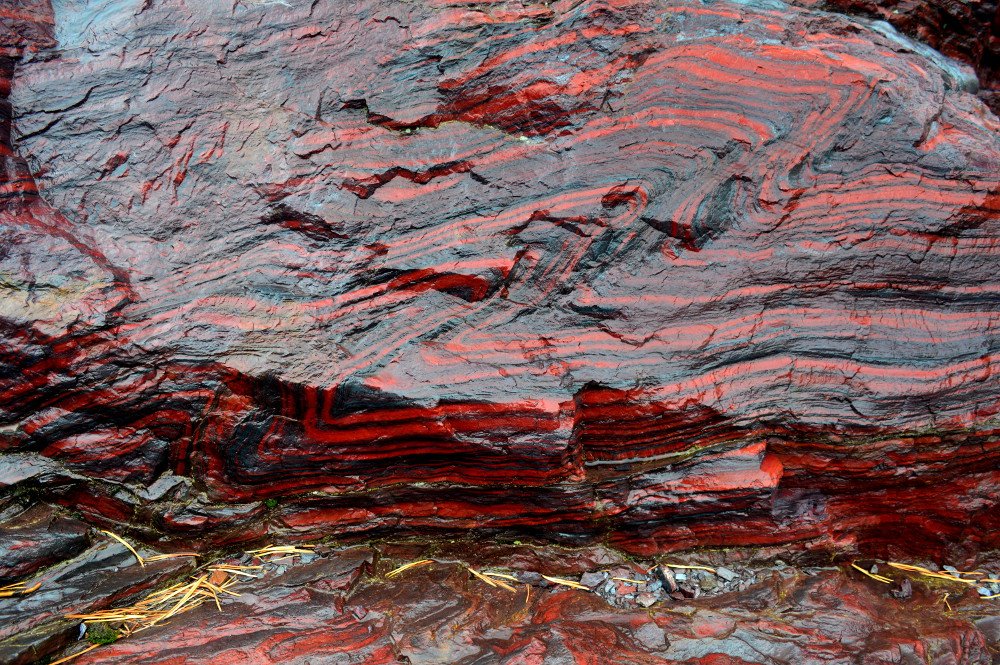Meet BIF— The World’s Toughest Rock
Banded Iron Formation from Ishpeming, MI. Photo by Craig McClarren
What is the most durable rock on earth?
Without a doubt, the title holder for “World’s Toughest Rock” (not a mineral, but a rock… so forget about something like “diamond”) goes to Banded Iron Formation, or at least to a closely related variety of ironstone (there are several).
Anyone who’s ever dealt with Banded Iron Formation, which we usually refer to as BIF, knows that it’s a beautiful rock that is also an absolutely gnarly beast to break or cut. The reason for that is pretty simple: BIF is composed of alternating layers (bands) of quartz, which is already a pretty hard material, and hematite. Hematite is Fe2O3. It is hard. It is iron. It is not your friend if you’re trying to do anything with it. Those alternating bands tend to reinforce each other, too, making it even more difficult to work with!
BIF with a pair of feet for scale. Photo by Craig McClarren
Michigan’s far north actually has quite a lot of banded iron formation— it’s one of the major ores that are mined from the Upper Peninsula’s Iron Ranges. In fact, it’s a fairly uncommon rock around the world, but it hasn’t always been. It was probably the most common rock in the world at one time, long, long ago.
So why is it uncommon now?
The simple answer is that banded iron can no longer be made on Earth. The conditions required to form BIF haven’t existed in about one-and-a-half billion years!
BIF is composed of alternating layers of quartz (or chert) and hematite- the photos in this article were all taken from one of the most beautiful examples in the world: Jasper Knob in Ishpeming, MI (which is billed as the world’s largest gemstone). These photos show three types of banding: red hematite bands, silver specular hematite bands and infrequent quartz bands.
Alternating bands of red cherty hematite and specular hematite. Photo by Craig McClarren
These rocks (and all BIFs) were formed on the ocean bottom. Prior to one-and-a-half billion years ago, there was very little oxygen in the atmosphere or the water. Our atmosphere was chock full of carbon dioxide, as were the oceans. There was almost no free oxygen at all. The dominant life form on earth was cyanobacteria— basically algae. Algae take sunlight and carbon dioxide (CO2) and convert it to energy, exhaling an extremely toxic gas. Toxic to them, that is… oxygen!
So you need to picture a hot greenhouse planet with barren rocky landscapes. There are no animals, no plants. Only bacteria, basically just algae. Life only exists in the oceans and along their edges. Those oceans are acidic and hot and… bright green. They’re green because they’re loaded with reduced iron which is dissolved in the water. But as the algae booms and takes over the oceans, they create runaway out-of-control oxygen pollution (keep in mind that there are no animals at that time that breathe oxygen and turn it back into CO2). That oxygen is dissolved into the water where it instantly reacts with the dissolved reduced iron. The water turns red with rust and oxidized iron rains onto the seafloor, coating it in a layer that will become a band of hematite. Eventually, the oceans begin to run out of iron and the oxygen begins to saturate the water. The algae have just polluted themselves into a mass die-off.
Algae and diatoms and single-celled life die off, their tiny skeletons raining onto the seafloor to create a layer of silica that will one day create a band of quartz. After the mini-extinction event, iron from erosion of rocks on the nearby continents once again fills the oceans, converting all the oxygen into rust that rains out. And then, with the oxygen gone and the oceans once again turning green with reduced iron, the algae returns in force for another boom with an accompanying burst of oxygen pollution. The process repeats again. And again. And again. For literally hundreds of millions of years, creating thousands of feet of ironstone rocks in some places made of hundreds of thousands of alternating bands.
Obviously, this no longer happens… thank goodness! Although we certainly seem to have learned absolutely nothing from those bacteria as we do the exact same thing to our own atmosphere, but with CO2 instead of oxygen. But that’s not the point of this article…
You can see the ancient and wild boom-bust cycle of algae and its oxygen pollution in the bands of these rocks. Photo by Craig McClarren
BIF is incredibly tough, but it can be a little brittle, so if you’re lucky enough to just find a thinnish sheet of it lying around with just a few layers, it can be broken. If you’ve got a big block of the stuff, though, you’ll never break it. You just won’t. It is harder than pure iron. You will do more damage to the rock hammer that you’re beating it with than you’ll actually do to the rock itself. Trust me, I know this. I was president of the Michigan Tech Geology Club half a lifetime ago and we visited the iron country all the time. You can’t pound your way through it.
Jasper Knob is a literal mountain of BIF. A small mountain, mind you, but it’s a lot! Photo by Craig McClarren
As a fundraising exercise, back when I was an undergraduate and president of the Geology Club, we made and sold rock clocks. Using a rock saw, we’d cut slabs of rock, coat them with resin or lacquer (I can’t really remember what it was now), drill a few holes through, put some numbers, clock hands and a little battery motor on the back and bam: you’ve got a gorgeous clock that we’d sell to fund our club. Well, someone collected a couple of enormous blocks of BIF and suggested we try it out. I was skeptical, but I told him that if he wanted to run it through the rock saw, himself, he was welcome to. It took him more than two hours to cut a single slab. The rock saw blade was absolutely useless after that- that BIF ate through the blade like it was made of tin. Sheer determination led to him getting two BIF slabs cut before the department put a stop to it, with very justifiable worries about its equipment. They made gorgeous clocks, but it was insane to try in the first place.
Definitely not a BIF clock, this is an epidote clock made in the style described. It’s the only example I have now. Photo by Craig McClarren
Also, if you want to talk about durability, let’s talk about durability.
The BIF in these pictures is 1.8 billion years old. Billion! That’s seven times older than the very first dinosaurs!
I’d like to point out something else unique and beautiful about these BIFs at Jasper Knob. You may have noticed very wavy or swirling patterns. That’s not your imagination. These rocks underwent what we call “soft sediment deformation.” That is, before these rocks actually turned into rock- while they were still soft and rather “oozy”- they were squished up and folded every which way. There are few examples in the entire world more beautiful than these. These rocks were once photographed for the covers of geology textbooks, though vandalism has ruined much of what you can see (someone has set explosives in cans of paint and detonated them all over in a senseless act that does nothing to harm the rocks, but really ruins our ability to enjoy them pristinely). So with that soft sediment deformation, you get very wild and dramatically sharp folds all over the place. We know the sediments were soft because a hard rock would have just broken and created faults. This was squished and squeezed like play-doh.
Banded Iron Formation at Jasper Knob. Photo by Craig McClarren
Michigan has many hidden treasures; it’s banded iron formation rocks remain one of it’s most underappreciated and underrated. Their age and the stories they tell make them so much more than just their gorgeous appearance. There are many places in the Iron Ranges around Marquette and the Western UP where you can appreciate these spectacular rocks, but one of the best is without a doubt Jasper Knob.
It’s a hard place to find, but there is public access to this private property and it’s legal to visit, but illegal to collect from- there are many other places, including many roadcuts, where you can collect just as nice samples. Jasper Knob is a wonderful place, home to some of the toughest, most beautiful and most ancient rocks on Earth- one of Michigan’s greatest treasures: BIF!
The author enjoying the view of Ishpeming from Jasper Knob several years ago. Photo by Craig McClarren









